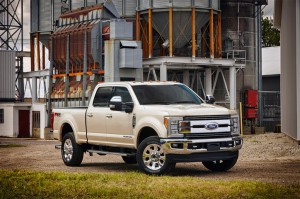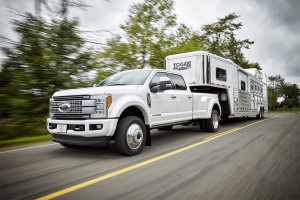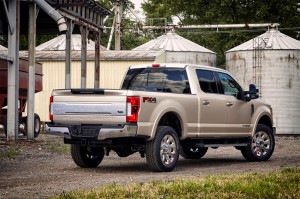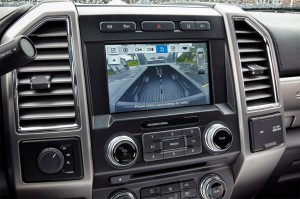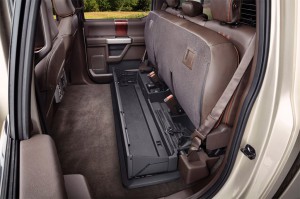Ford is cutting some of the mass, but increasing the capabilities, of its biggest trucks, the 2017 F-Series Super Duty.
Officially making a debut at the State Fair of Texas today, the heavy-duty models follow the more mainstream Ford F-150 model in switching from traditional steel to a lightweight aluminum body. That’s something Ford says will reduce the weight of the trucks by as much as 350 pounds. At the same time, the maker beefed up the towing and cargo capacity of the Super Duty models, it said.
“There’s more change to this story than there was with the F-150” which went on sale for the 2015 model-year, explained Doug Scott, F-Series marketing manager, during a background briefing TheDetroitBureau.com attended.
The light-duty F-150 lost as much as 700 pounds when it made the switch from a steel to “aluminum-intensive” body. The move was controversial, in part, because of questions about both durability and maintenance costs, but after a slow start, the full-size models have begun to gain real traction in the marketplace because of their increased capabilities and lower fuel costs.
Ford is betting it will do even better immediately out of the gate with the F-Series Super Duty models.
(Ford shows new global Ranger. Click Here to find out if it’s coming to the U.S.)
While Ford often lumps its pickups together as the F-Series, there are actually a broad range of different models, such as the F-150, F-250, F-350 and even bigger versions. They come in standard, crew and chassis cabs, and also are sold without beds, buyers converting them into everything from jitney buses to tow trucks to emergency vehicles.
“This is a business of niches,” noted Scott.
What they all have in common is the need for ruggedness and reliability. Capacity – both towing and cargo – counts. And despite the plunge in gasoline prices, fuel economy matters.
The Super Duty models sit about four inches taller, and they get a slightly more rugged design makeover than the light duty F-150 line. The grilles are bigger — plural because there are a number of versions of the heavy duty line-up, each with slightly different exterior detailing.
As with the F-150, the Ford Super Duty line not only is offered in big, bigger, biggest versions, but allows buyers to opt for base, mid-range or near-luxury versions. Ford recently added the F-150 Limited, pushing into the $60,000 range, and may soon do the same for the Super Duty line, officials hinted. As it is, the most expensive version today can hit $70,000 – before customization.
While the Super Duty models now will shift to aluminum for their bodies, the 2017 models will stick with steel for the rest of the vehicle. More precisely, Ford is significantly increasing the use of high- and ultra-high-strength steels. They offer greater capabilities while offsetting potential weight gains.
(Click Here for a review of the new 2016 Toyota Tacoma.)
A new, fully-boxed frame is another reason that chief engineer Craig Schmatz suggested the new trucks will deliver a big boost to towing capacity, now a maximum 32,000 pounds, as well as payload, currently topping out at around 8,000, depending upon the model. Ford is holding back specific capacity and fuel economy numbers until closer to the vehicle’s on-sale date around a year from now.
About the only thing not getting a makeover is the Super Duty powertrain line-up. It’s a carryover, with a 6.2-liter V8 for the F-250 version, and a more powerful 6.8-liter V10 for the full line-up. Both are gasoline engines. The dominant powertrain, however, is the 6.7-liter V8 turbo-diesel. The most notable change under the hood is the addition of a new six-speed automatic for the F-250. Specific horsepower, torque and mileage numbers will come closer to launch.
Like the 2015 Ford F-150, the new Super Duty models will add plenty of accessories to enhance both comfort – with touches like an optional massaging driver’s seat – and functionality, as well as safety.
Among the latter category are such features as blind spot detection, active cruise control and land departure warning.
The new Ford Super Duty will offer up to seven high-resolution cameras. They can provide a birds-eye view of the big truck’s surroundings, useful for parking or driving through tight spaces. One of the cameras points down at the cargo bed, another is removable and can be mounted on the back of a trailer, the image displayed on the truck’s instrument panel.
There’s a new adaptive steering system to make parking and creeping on a work site easier. There’s even a hidden storage box beneath the rear seats. But while there’s the updated Sync 3 infotainment system, there’s no WiFi hotspot offered on Chevy and Ram trucks.
The rollout of the F-150 was painful, in part, because of the extensive conversion process required for producing aluminum bodies at Ford’s F-Series plants. That’s now in the past, and Ford experts to transition from old to new Super Duty models much more painlessly.
It has to hope so. The collective F-Series line-up has been the country’s best-selling pickup nameplate in the U.S. for 38 years, and the best-selling vehicle overall for 33.
Ford officials are coy about sales numbers when discussing the F-Series Super Duty line. They note that heavy-duty trucks typically account for 30% of overall full-size pickup sales. Industry data suggest Super Duty runs slightly higher.
Both Ford’s light and heavy-models are facing more competition, however. Rival Chevrolet is rolling out new pickup variants, for both the big Silverado and midsize Colorado, at the Texas State Fair. Nissan, meanwhile, has an all-new version of the full-size Titan coming shortly.
(Mercedes expanding U.S. plant to boost SUV production. Click Here for more.)

